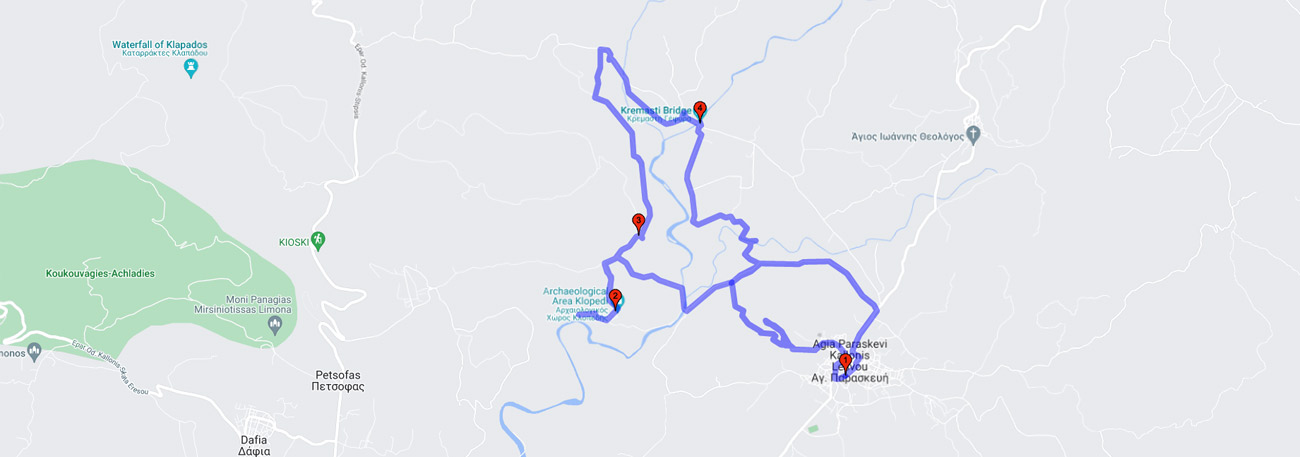Agia Paraskevi - Iero Klopedis - Metochi Taxiarchon - Kremasti bridge - Stivota - Agia Paraskevi

| General description: |
Hiking trail with great cultural interest amidst olive groves, pine forests, heaths of heather, scattered oak trees, areas with piles of harvested wheat, cultivated lands of Kambos, monasteries & chapels, old springs, stone-paved paths, threshing floors. |
| Detail description: |
In the center of Lesvos, the village of Agia Paraskevi with its mansions from the old times and remarkable folk culture is the "starting point" for hiking to the island's famous monuments. In the area of the route, fields alternate with olive groves and pastures, while the scattered large oak trees with their various colors mark the seasons. To the west, the valley of the Tsiknia River stretches out. Across the river, the Klopei area begins with the prominent archaeological site of the Aeolian Sanctuary, founded in the 8th century BC. Also newer is the Christian worship and ascetic space of the Monastery of Taxiarchs or Klopedi Dependency, a building in a Lesvos monastic style, located one kilometer to the north. Signs lead to a meeting with the river, where the medieval hanging bridge of Kremasti is located, the largest in Lesvos. |
| Transportation means: |
Car and bus to Agia Paraskevi |
| Accessibility: |
Asphalted access to Agia Paraskevi, connection to rural road construction |
| Best season: |
Spring, Autumn |
| Places to visit: |
Settlement of Agia Paraskevi and the museum of Elia, Aeolian sanctuary of Apollo, Metochi Klopedis, Kremasti bridge |
| Signage: |
Yes |
| Route starting point: |
Agia Paraskevi |
| End of Route: |
Agia Paraskevi |
| Type of tourism: |
Walk/hike, cultural |
Points of interest
Agia Paraskevi
| Name: |
Agia Paraskevi |
| Description: |
Settlement |
| Category: |
Cultural elements |
| Longitude: |
39.246533 |
| Latitude: |
26.270485 |
| Altitude: |
94 |
The village is built on a plain surrounded by low mountains planted with olive trees and small naked hills. Almost all of the settlement consists of rural and urban houses built with the traditional architecture of Lesvos. Among them stands out the building of the Schools, the Town Hall, and the Church. At the entrance of the village, there are old industrial buildings, mainly olive presses. One of them has been restored and houses a model industrial museum, the Olive Museum. Agia Paraskevi has traditional cafes and picturesque grocery stores that a visitor should "explore". At the beginning of summer, the Festival of the Bull takes place, a three-day festival dedicated to Saint Charalambos, with several references to bullfighting.
Iero Klopedis
| Name: |
Iero Klopedis |
| Description: |
Archaeological site |
| Category: |
Cultural elements |
| Longitude: |
39.252213 |
| Latitude: |
26.246061 |
| Altitude: |
95 |
Nikean buildings, known in archaeological literature as Temples A and B, were erected on the rocky peak of the slope in the 6th century BC, on top of earlier remains, which were carefully incorporated into their foundation. They are impressive remains of two religious buildings that remain to this day the only examples of Aeolic rhythm in Lesbos and the Hellenic world. Recent excavations testify to the deity to whom the sanctuary was dedicated: a bronze statue of a young man and an inscribed plaque with the engraving [APOL]LONOS reveal the identity of the deity and strongly link the worship of the sanctuary to the god of Light.
Metochi Taxiarchon
| Name: |
Metochi Taxiarchon |
| Description: |
Church/Monastery |
| Category: |
Cultural elements |
| Longitude: |
39.259925 |
| Latitude: |
26.246061 |
| Altitude: |
106 |
The Metochi of Taxiarches is located very close to the archaeological site of the Sanctuary of Klopedi and its church, which is dedicated to the Archangels Michael and Gabriel, celebrates on September 6th (commemoration of the Miracle of Taxiarchis Michael in Hones).
The Metochi of Taxiarchs in Klopedi belongs to the Monastery of Agios Ignatios, known as the Monastery of Leimonas, and the monastery was founded by Saint Ignatios of Agallianos himself in the 16th century. The building complex follows the unique architectural form of the Lesbos monasteries.
Kremasti bridge
| Name: |
Kremasti bridge |
| Description: |
Bridge |
| Category: |
Cultural elements |
| Longitude: |
39.270314 |
| Latitude: |
26.253189 |
| Altitude: |
77 |
Perhaps the most impressive and beautiful bridge in Lesvos. What is certain is that it is one of the most noteworthy examples of traditional architecture on the island, an elegantly preserved monument to the history of the island. It is a single-arched bridge with a height of 8.5 meters and a span of 14 meters. The length of the curved and paved surface is about 50 meters and the width is approximately 3.50 meters. Carved rectangular stones, three in each row (across the width), form a circular arch that is as thin at its peak as the width of a single stone. The bridge is thought to have been built during the period of the Gattelouzi rulers of Lesvos (1355-1462) to serve their military purposes.
The route
